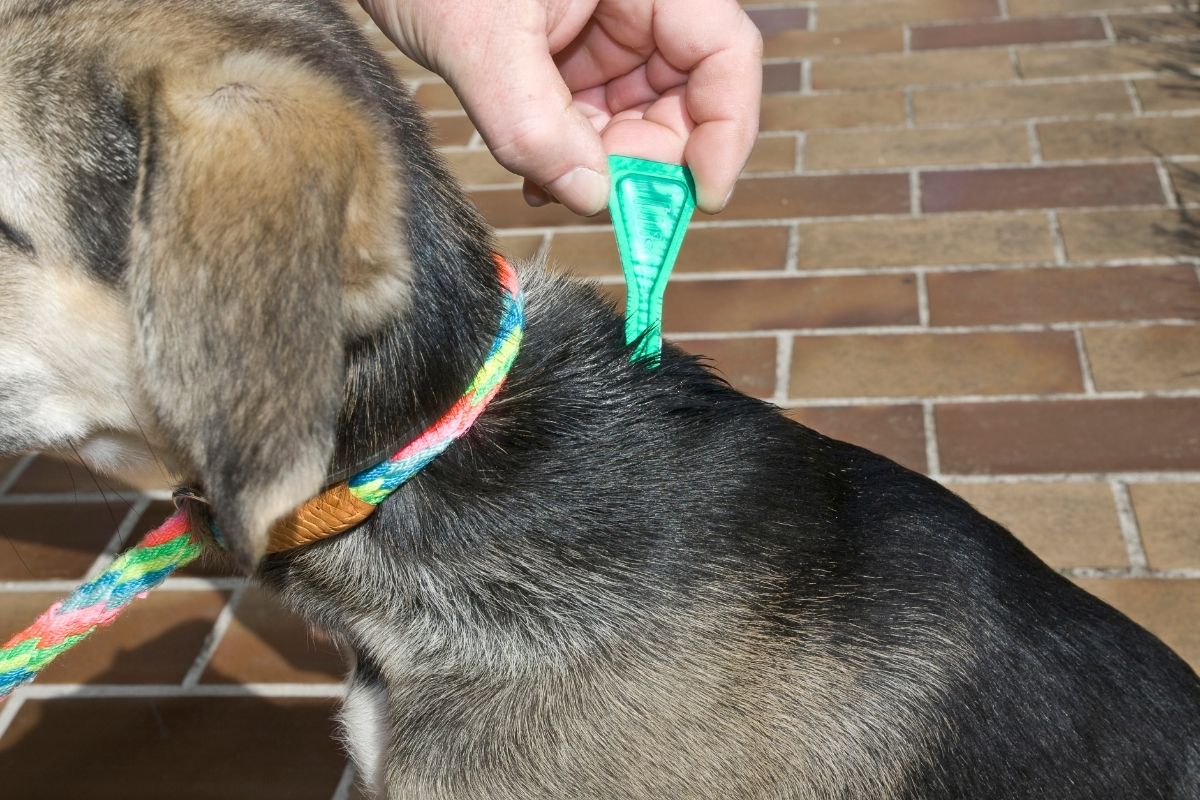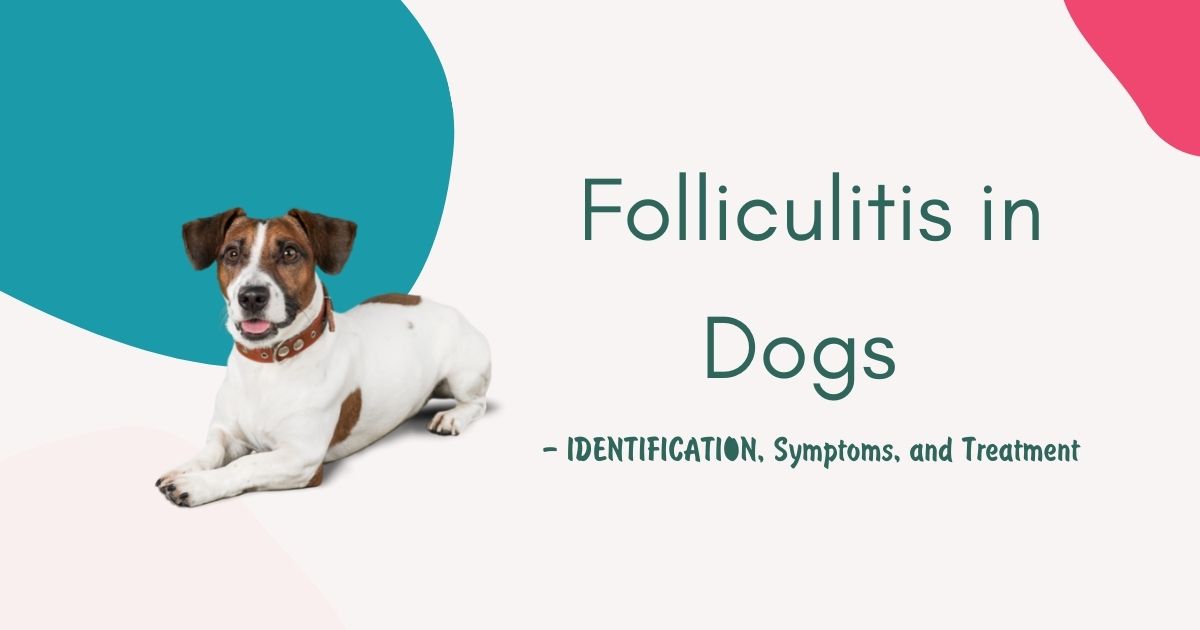Dogs and Folliculitis
Are you itching to know more about folliculitis in dogs? The term folliculitis refers to inflammation of the tunnel-shaped structure in the outer dermal layer of the skin that anchors the hair in place. The inflamed hair follicle will have a “goosebump” like appearance but may also have a small pimple, crusty, or scaly surface around the affected area.
It is an unusual term, so naturally, many may wonder, “What is folliculitis in dogs?

The Identification and Symptoms of Folliculitis in Dogs
The initial development of folliculitis in dogs can be very subtle and difficult to detect early. So often, the progression of the inflammation is quite advanced by the time it is noticeable. The lesion may sometimes resemble an ingrown dog hair, a clogged hair follicle, or an infected hair follicle. Very early signs may include:
- Loss of coat luster.
- Increased shedding.
- Coat texture may feel coarser.
- Increased white flakes (dry skin) on your pet’s coat surface.
- Itching: dogs who obsessively scratch or over-groom can introduce bacteria or fungi into their skin if they scratch or bite the skin open.
Dogs have a significant number of hair follicles, and each dog has individual variations in the type and thickness of hair. The areas that most dogs show signs and symptoms of folliculitis are in high friction areas, like the groin and the axilla (armpits), and in high contact areas, like the abdomen.
It is essential to groom your pets and monitor their coat regularly and underlying skin conditions to detect changes early. For example, long-coated dogs will develop mats or crusted hair tufts in affected areas, whereas short-coated dogs will have raised hair tufts.
Once these signs are noticed, part the coat in the affected area. You may see the following symptoms:
- Swollen or raised patches of skin.
- Discoloration of the skin can either be redness from inflammation or darker areas due to hyperpigmentation from chronic inflammation. This is particularly evident in the groin area of dogs suffering from folliculitis.
- Whitish raised areas can be pustules or pimples.
- Hair loss can be evident in patches or areas with thinner coat consistency and more visible areas of skin- it can also be due to broken hair shafts from chronic biting due to itching skin.
- Reddish swellings (known as papules).
- Circular areas of crusty or scaly skin and hair loss are known as epidermal collarettes.
- The tunnel-like shape of the follicle can result in the formation of draining tracts.
- Blackheads or pinhead-sized black dots are not advised to be squeezed out, leading to more inflammation and the possibility of infection.
Are Any Dog Breeds Predisposed to Canine Folliculitis
All dogs have hair and can therefore develop folliculitis, but certain breeds listed below do have a predisposition:
- Boston terriers
- Boxers
- Bulldogs
- Bull terriers
- Dalmatians
- Golden retrievers
- Jack Russel Terriers
- Labrador retrievers
- Shar-peis
- Scottish terriers
- West Highland white terriers
- Wirehaired fox terriers
How to Treat Folliculitis in Dogs
How to treat Folliculitis in dogs can include the following approaches:
- Topical therapy: This means that medication will need to be applied directly to the affected area
- Systemic therapy: This medication is administered orally to combat either infection or hormone imbalances.
- Underlying cause treatment: The primary cause of the condition needs to be addressed; otherwise, it will recur.
Bacterial Folliculitis
Antibiotic treatment is necessary if there is superficial bacterial folliculitis. The treatment can sometimes extend from one to 12 weeks, depending on the initial cause and severity of the condition.
Fungal Folliculitis
Topical treatments like ointments or shampoos may be prescribed to treat fungal infections, but oral medication may be necessary for several months for severe systemic infections like blastomycosis.
Endocrine Disorder Folliculitis
Endocrine disorders can only be treated if diagnosed and managed effectively, with strict medication schedules and follow-up consultations.
Hypothyroidism is easy to manage with daily chronic medication, but conditions like Cushing’s may need a combination of chronic medication and possibly surgery, depending on the origin of the hyperadrenocorticism.
Parasite-induced Folliculitis
There are several recommended products for treating parasitic-induced folliculitis, which can be either topical or oral. Active ingredients need to target the specific parasite, so be sure to discuss this with your veterinarian to ensure you are using the right products.
Home Remedies
Certain natural products can be used to alleviate some symptoms of folliculitis but always confer with a veterinarian about additional treatments to ensure they do not compromise any treatment outcomes being monitored.
Home treatment using apple cider vinegar for folliculitis in dogs can be considered with a yeast infection. However, it is important to note that even though home remedies may soothe symptoms, they will not treat the cause.
Can Canine Folliculitis be Prevented?
Preventing folliculitis can be easy if common causes are prophylactically treated:
- External parasites- regular preventives for skin parasites are readily available from most pet outlets or veterinarians.
- Grooming is essential as it helps you monitor your pet’s overall coat condition and avoid high bacterial or fungal loads from the environment by using appropriate pet shampoos.
- Regular vet checks to monitor dogs who may have itchy skins.
Ensure dogs with allergies stick to their prescribed medication or food because this helps maintain their healthy skin barrier and moderates their immune reactions to possible allergens.
Causes of Folliculitis in Dogs
Folliculitis is a clinical presentation of an underlying condition- this means that a hair follicle does not spontaneously just develop a problem on its own. Instead, folliculitis is a secondary consequence due to an underlying primary issue. What causes folliculitis in dogs is briefly outlined below.
Bacteria
The most common cause of folliculitis in dogs is bacteria. Bacteria, known as commensal bacteria, naturally occur on the skin and are generally benign. They are a part of a dog’s natural skin barrier.
Bacteria becomes a problem when the skin barrier becomes compromised, either through an injury or through other means by which non-commensal bacteria over-proliferate and cause an infection.
Commensal bacteria like Staphylococcus species are the most common organisms that cause bacterial infections when the skin barrier is compromised.
Superficial bacterial folliculitis needs to be treated either with topical medication or systemic antibiotics, but it is always best to consult your vet to discuss treatment options.
External Parasites
Fleas, mange mites, and other biting insects can cause inflammation or hypersensitivity, so it is important to ensure that your pet receives the appropriate prophylactics to avoid insect bites.

Fungal Infections
Introduction of fungi from chronic scratching or injury happens occasionally. This, in turn, can cause a significant inflammatory response and infection of the hair follicle. For example, ringworm is a commonly seen fungus and can be transmitted to owners and other pets. Another fungal cause of folliculitis that is quite serious is blastomycosis which requires systemic treatment.
Systemic Disease
Systemic diseases like Cushing’s Syndrome or hypothyroidism can affect skin health and compromise the skin barrier. So, what appears to be superficial folliculitis could be a secondary effect of the primary condition.
It is crucial to monitor your pet closely if they have recurring bouts of skin infections or a poor coat condition, as it could mean there is an underlying issue that has not yet been diagnosed.
Remember to mention signs out of the ordinary like increased water intake, increased urination, heat-seeking behavior, chronic scratching, poor healing time or abdominal distention, and hair loss.
Immune System Disorders
A significant number of animals have overactive immune systems or hypersensitivity disorders that can manifest as skin conditions.
Allergies and hypersensitivity that cause folliculitis will need to be investigated, and several treatments may be done before finding the correct one. Therefore, patience and compliance are vital in treating allergies.
Immune system disorders like pemphigus foliaceus or discoid lupus are rare conditions with a high prevalence in breeds like German Shepards.
Many people wonder if folliculitis in dogs is contagious to humans. The answer lies within what causes the folliculitis in dogs in the first place. Bacterial, fungal, and parasitic causes can cause lesions in humans. Check with your vet if you or a family member have similar lesions to your pet.
Summary
Don’t split hairs about folliculitis. Instead, monitor your dog’s overall coat condition regularly, detect early signs and symptoms, and avoid severe flare-ups.


1 thought on “Folliculitis in Dogs – IDENTIFICATION, Symptoms, and Treatment”
Comments are closed.